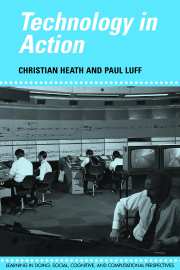Book contents
- Frontmatter
- Contents
- Preface
- 1 Technology and social action
- 2 Documents and professional practice: ‘bad’ organisational reasons for ‘good’ clinical records
- 3 Animating texts: the collaborative production of news stories
- 4 Team work: collaboration and control in London Underground line control rooms
- 5 The collaborative production of computer commands
- 6 ‘Interaction’ with computers in architecture
- 7 Reconfiguring the work space: media space and collaborative work
- 8 Organisational interaction and technological design
- References
- Index
7 - Reconfiguring the work space: media space and collaborative work
Published online by Cambridge University Press: 22 September 2009
- Frontmatter
- Contents
- Preface
- 1 Technology and social action
- 2 Documents and professional practice: ‘bad’ organisational reasons for ‘good’ clinical records
- 3 Animating texts: the collaborative production of news stories
- 4 Team work: collaboration and control in London Underground line control rooms
- 5 The collaborative production of computer commands
- 6 ‘Interaction’ with computers in architecture
- 7 Reconfiguring the work space: media space and collaborative work
- 8 Organisational interaction and technological design
- References
- Index
Summary
Introduction
Over the past decade or so some of the most interesting technical innovations have involved the integration of telecommunications and computing. The videotelephone and the videoconference suite are the rudimentary precursors to these innovations, innovations which attempt to reconfigure the work space, and provide a rich and flexible environment for work and collaboration amongst distributed personnel. These innovations attempt to go well beyond conventional file or document sharing. They attempt, in various ways, to build environments which provide individuals not only with (vocal and visual) access to each other, but to the variety of tools, artefacts and objects on which work ordinarily relies. One need, however, go no further than consider character of work and interaction found in the settings discussed earlier to envisage the difficulties in developing technologies to support the distribution of such activities, and, as yet, these technical innovations have largely failed to provide satisfactory domains for collaboration.
At the cutting edge of innovations to support real-time interaction and collaboration, at least a few years ago, were systems generally known as ‘media spaces’. Media spaces consist of audio-visual and computing infrastructures which provide individuals with ‘multimedia’ real-time access to one other. For example, at PARC, Xerox Research Laboratories in Palo Alto, a video-window was established which provided scientists with audio-visual access to a common area in a related laboratory 600 miles away in Portland (Olson and Bly, 1991). A similar video-window facility was established at Bellcore (Fish et al., 1990).
- Type
- Chapter
- Information
- Technology in Action , pp. 179 - 216Publisher: Cambridge University PressPrint publication year: 2000

